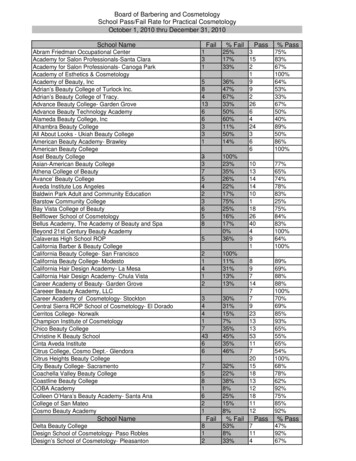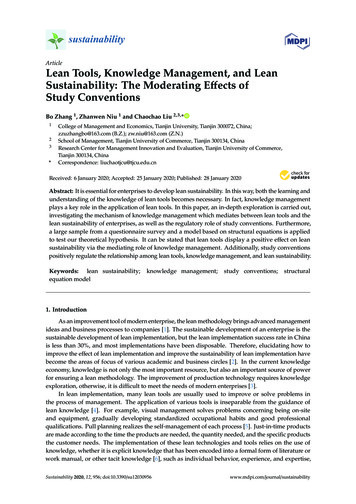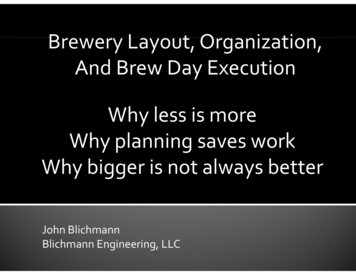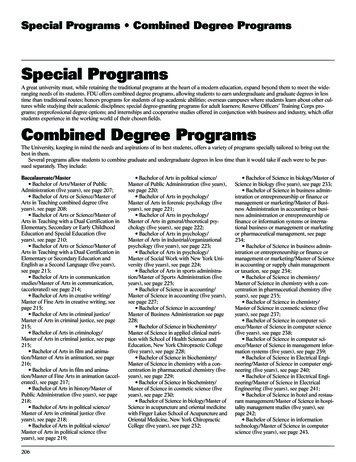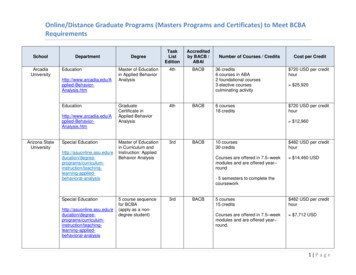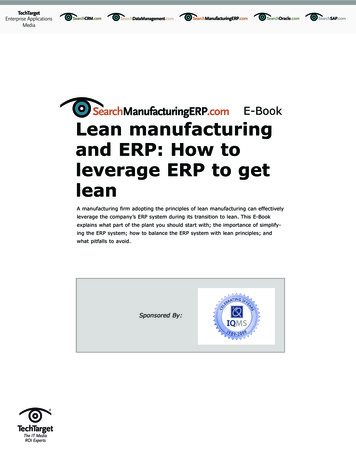
Transcription
Why Lean Programs FailBy Jeffrey Liker and Mike RotherToyota’s success has inspired tens of thousands of organizations to adopt some form of alean program. The term was introduced in The Machine That Changed the World and laterin Lean Thinking as a new paradigm that was as monumental as the shift from craft-style tomass production. The focus of lean is on the customer and the value stream. You can say itis a pursuit of perfection by constantly eliminating waste through problem solving.Certainly an organization that is truly dedicated“We have both concluded fromto becoming lean is on a path toward excellence.our different journeys andYet a large survey conducted by Industry Weekexperiences with companiesin 2007 found that only 2 percent of companiesthat people have had athat have a lean program achieved theirfundamental misunderstandinganticipated results.1 More recently, the Shingoof what the Toyota ProductionPrize committee, which gives awards forSystem is in practice.”excellence in lean manufacturing, went back topast winners and found that many had not sustained their progress after winning the award.The award criteria were subsequently changed.2 Why is the pursuit of excellence throughlean so difficult?Where Does Improvement Come From?When we look at a Toyota plant, we see many good ideas, and it appears that the companyhas a department of Toyota Production System (TPS) geniuses who design and implementall these lean innovations. We might ask whether these ideas are standardized andimplemented in all Toyota plants in the exact same way. Are the TPS experts telling theplants what to do and auditing them to see if they are following the best practices?The reality is that very little that you see at a Toyota site is the result of one person with abig idea that got standardized across plants. More often, what you see is today’s condition,which is the result of many small steps, some of which were discarded and othersembraced. It was the result of many cycles of plan-do-check-act (PDCA), and it is differentthroughout Toyota because different organizations are on different learning cycles.1 Everybody'sJumping on the Lean Bandwagon, but Many are Being Taken for a Ride. IndustryWeek, May 1, 2008.2Robert Miller, Executive Director of the Shingo Prize, interviewed on radiolean.com, July, 2010."About 3 years ago we felt we needed deep reflection. After 19 or 20 years we went back and did asignificant study of the organizations that had received the Shingo Prize to determine which oneshad sustained the level of excellence that they demonstrated at the time they were evaluated andwhich ones had not.We were quite surprised, even disappointed that a large percentage of thoseorganizations that had been recognized had not been able to keep up and not been able to moveforward and in fact lost ground . We studied those companies and found that a very largepercentage of those we had evaluated were experts at implementing tools of lean but had notdeeply embedded them into their culture."lean.orgLean Enterprise Institute1
Mike Rother, who has spent years researching how Toyota does what it does and how tobetter teach companies that are on a quest for excellence, summarizes what he found in theconcept of the improvement kata, which he suggests underlies striving to meet challengesat Toyota. A kata is a well-rehearsed routine that eventually becomes second nature. In thiscase, the routine is the process for making improvements.We have both concluded from our different journeys and experiences with companies thatpeople have had a fundamental misunderstanding of what the Toyota Production System isin practice. We mistook lean solutions for the process that leads to what we see in a Toyotaplant. We need to look more deeply at the human thinking and processes that underliespecific practices that we observe.For example, early in our understanding of TPS we thought of heijunka as a powerful toolto level the workload and reduce inventory. But what we found from our experiences withcompanies was that establishing the heijunka pattern itself changes little in most cases.What is more important is the behavior generated by viewing the heijunka pattern as atarget condition and following the improvement kata in striving to achieve it. It's thesystematic, iterative working through the obstacles, step-by-step, that actually improvesprocesses, and it takes practice to acquire the skills and mindset for how to do that.Similarly, the overt purpose of kanban is to provide a way of regulating productionbetween two processes, so that the supplying process produces only what is needed when itis needed. The invisible purpose of kanban, which we missed, is to provide a targetcondition. Kanban is a predetermined pattern between a supplier and customer processthat, with the right leadership and culture, is used to generate behavior to work through theobstacles to achieve that target condition.The difference between the visible and invisible purposes of heijunka, kanban and otherlean tools is the difference between attempts at implementation of tools, and using the toolsas part of deliberately practicing a routine for continuous improvement.Learning a New Way of Thinking and ActingRecent findings in neuropsychology demonstrate that people develop well-worn neuralpathways that make it comfortable to do things the same way again and again. Whilehumans derive a lot of their sense of security andconfidence from this, the content of what we do“An antidote to this dilemma ofwill in fact be changing, whether intentionally orresistance to change is tonot, because conditions are always changing. Andevelop strong mental circuitsantidote to this dilemma of resistance to change isnot for solutions, but for how toto develop strong mental circuits not for solutions,develop solutions.”but for how to develop solutions.The management task, then, is to have the organization's members practice a behaviorpattern, like the improvement kata, that achieves this. We need a routine not just for doingthe work, but for continually improving the work. That routine is missing in organizationsthat use top-down management objectives, so managers have no choice but to blindly startlean.orgLean Enterprise Institute2
cutting things.The improvement kata is a way we can break down an abstract vision into a series ofdescriptive target conditions, and through striving to achieve them both develop and utilizethe creative powers of people.It involves teaching people astandardized, conscious meansof grasping the essence ofsituations and respondingscientifically by workingiteratively. The improvementkata is a routine to teach andlearn that mobilizes people’scapability to achieve desiredconditions. The improvementkata is a way to achieve thingsthat you don't know how youare going to achieve.Toyota’s improvement katahas been taught implicitly insome parts of Toyota fordecades. The TPS mentor would do this by giving the student a challenge, such as to makea breakthrough in performance in a process (e.g., combine these two production cells intoone mixed model cell that operates on two shifts with four people and can respond tochanges in customer demand). Even if the mentor has a notion of how the challenge mightbe achieved, he does not share it with the student. His task is to lead the student intodeveloping good habits for working through problems, via intensive questioning-basedcoaching on this problem.Teaching the improvement kata involves asking thesequestions every day.We missed this underlying skill and mindset development focus of TPS. For example, inan organization Professor Liker observed the COO decided to hold plant managersaccountable for running a certain number kaizen events to achieve a certain level ofproductivity improvement. It became slash-and-burn lean with no sustainability and nocontinuous improvement, i.e., old school, outcome focused, carrot and stick motivation.These days there is more structure to Toyota's coaching process, but the relationshipbetween mentor and student is at the core of how Toyota gets improvement to be a deeplyembedded routine. To have enough coaches they are often the direct managers of thestudents, but the managers can always use training too and should themselves have a coachfrom inside or outside the organization.There seems to be a strong belief in Western business that you select people with goodinnate work/management characteristics (habits), and then you give them outcome targets.In contrast, Toyota selects people for their openness to learning, and then develops thelean.orgLean Enterprise Institute3
desired work/management characteristics (habits) through practice after they hire in.Neuroscience is showing us that the adult human brain is more plastic than we believed,and that's what Toyota is taking advantage of in order to develop a deliberate culture.Challenge Demands LearningResearch has repeatedly shown that when a task is relatively easy -- i.e., when the path tothe target condition is pretty clear -- then managing by results and with extrinsic motivatorscan work well enough. The task is basically to get it done, and the organization's leadersneed not overly concern themselves with ensuring that people are employing a systematic,scientific approach to achieving the target condition.On the other hand, if the task is a challenge -- i.e., the path to the target condition is unclearand has to be discovered via iterative learning -- then managing by results and extrinsiccarrot and stick motivators does not compete so well. In that case, how people go aboutstriving for their target conditions becomes important, and, in competitive markets, issomething with which leaders will need to concern themselves.When we look at lean in this way it is not only a set of techniques for eliminating waste,but a process by which managers as leaders develop people so that desired results can beachieved, again and again. That means coaching people in practicing an improvement kataevery day.What is your company's improvement kata?Jeff LikerMike RotherFor More Information: “Toyota Kata: Mobilizing our ingenuity through good management” - Mike Rother’sLearning Session at the 2011 Lean Transformation Summit will give you insights andideas that will influence how you view your job as a lean manager and leader. In his e-letter “Glad That I Asked You,” John Shook describes the improvement kata inthe context of people and organizational capability development. Toyota Kata Homepage - Learn more about what an improvement kata is, downloadpresentations, key definitions, and much more. Jeffrey Liker’s Homepage - Read excerpts and get downloads from The Toyota Way.Become a fan of the book’s Facebook page.About the AuthorsJeffrey Liker, Ph.D., is professor of Industrial and Operations Engineering atthe University of Michigan and principal of Optiprise, Inc. Dr. Liker hasauthored or co-authored over 70 articles and book chapters and eight books.He is author of the international best-seller, The Toyota Way: 14 ManagementPrinciples from the World’s Greatest Manufacturer, which speaks to thelean.orgLean Enterprise Institute4
underlying philosophy and principles that drive Toyota’s quality and efficiency-obsessedculture. The companion (with David Meier) Toyota Way Fieldbook, details howcompanies can learn from the Toyota Way principles.Mike Rother is a researcher, an engineer, and a teacher on the subjects ofmanagement, leadership, improvement, adaptiveness, and change. He is coauthor of Learning to See, Creating Continuous Flow and the Training to Seekit. His latest book, Toyota Kata, is based on six years of research intoToyota's management practices.lean.orgLean Enterprise Institute5
It became slash-and-burn lean with no sustainability and no continuous improvement, i.e., old school, outcome focused, carrot and stick motivation. These days there is more structure to Toyota's coaching process, but the relationship between mentor and student is at the core of how Toyota gets improvement to be a deeply embedded routine. To have enough coaches they are often the direct .

